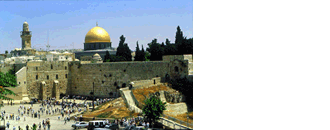
|
|
|
|
|
Class Prep
|
|
|
|
Repairing the World
- We end our quarter with a reflection on the Jewish mystical concept of tikkun ha-olam, or repair of the world. The Hebrew root ת-ק-ן appears in the biblical book of Qohelet (Ecclesiastes) and means "to straighten, to repair, to fashion." The Jewish rabbis used it to justify new procedures in religious life, particularly after catastrophes like the destruction of the Second Temple by Rome in 70 CE. In midrashic literature, it signals human beings' ongoing efforts to put the final touches on the God's work of creation.
|
|
Slideshow best viewed in IE, Firefox, Opera |
- When the term is combined with "the world," the meaning shifts to concern for social justice. For example, the rabbis applied the principle of tikkun ha-olam to divorce, where "repair of the world" signals the concern for the rights of the divorced woman, who is in the more vulnerable economic position. In liturgical prayers, it shifted from something humans would do to something God would do. And in the medieval mystical tradition known as the kabbalah, both meanings were merged; even the smallest human act could allow the divine presence to flow more freely to earth.
-
- Today, tikkun-ha olam enjoys a currency beyond Hasidic or kabbalistic circles. It is used broadly across the major Jewish denominations to refer to the betterment of the world, encompassing relief of human suffering, work for peace and mutual respect, and the protection of the planet from destruction. For most Jews, this is work that all must perform; for Orthodox thinkers, it is ultimately the work of the messiah, but Jews can engage in tikkun ha-adam—the improvement of humanity—until then.
-
- Just as the concept of tikkun ha-olam has come full circle, so have we. This quarter, we've studied the mythography, ethics and history of Judaism, Christianity and Islam. We have observed their encounters over the centuries and have seen how they contribute symbolic worldviews that are constantly adapted, for good and ill, to new circumstances.
-
- We also live in a postmodern world in which those symbolic worldviews have shattered in the wake of new catastrophes like the Shoah, world-scale wars, and pending ecological disaster. Jewish artist Samuel Bak captures our moment in his renderings of the myth of creation, as our secondary reading for today so eloquently describes. After you read this essay, consider our final journal question for the quarter: Can re-telling stories help to repair our world? You might consider this question first in your own life: has re-telling your own stories of significant moments in your life helped you deal with major changes? Then consider the application to scripture: how might the scriptural stories, laws, prophetic oracles, and visions, not only remain relevant, but actually assist us, in tikkun ha-olam?
-
-
- Assigned Readings
-
- Secondary: Danna Nolan Fewell and Gary A. Phillips, "From Bak to the Bible: Imagination, Interpretation, and Tikkun Olam," Arts 21:1 (2010) 21-30 (Camino)
-
-
- Slides from Lecture
-
-
- Further Reading
-
- Rosenthal, Gilbert S. "Tikkun ha-Olam: The Metamorphosis of a Concept." Journal of Religion 85:2 (2005) 214-40.
-
-
- Links
- Tikkun - A magazine based in Berkeley coming out of the Reform or progressive Jewish tradition.
-
- Sources
- Photographs:
- Samuel Bak, Creation (1999). Ítaca, cadernos de ideias, textos & imagens (24 October 2010). Online, http://itacarevista.wordpress.com/2010/
10/24/imagens-do-ensaio-«a-vocacao-das-perguntas»-de-ricardo-gil-soeiro-itaca-n-º2-pp-140-160/imagem-7-samuel-bak-creation-1999-2/, accessed 28 March 2012.
- Michelangelo, The Creation of Adam (1511). Ítaca, cadernos de ideias, textos & imagens (24 October 2010). Online, http://itacarevista.wordpress.com/2010/10/24/imagens-do-ensaio-«a-vocacao-das-perguntas»-de-ricardo-gil-soeiro-itaca-n-º2-pp-140-160/imagem-5-miguel-angelo-la-creazione-di-adamo-1511-2/, accessed 28 March 2012.
- Samuel Bak, Creation of Wartime III (2009). Ítaca, cadernos de ideias, textos & imagens (24 October 2010). Online, http://itacarevista.wordpress.com/2010/10/24/imagens-do-ensaio-«a-vocacao-das-perguntas»-de-ricardo-gil-soeiro-itaca-n-º2-pp-140-160/imagem-6-samuel-bak-creation-of-wartime-iii-2009-2/, accessed 28 March 2012.
|
|
|
|
|
